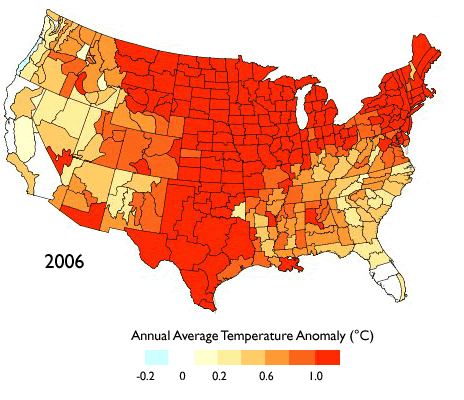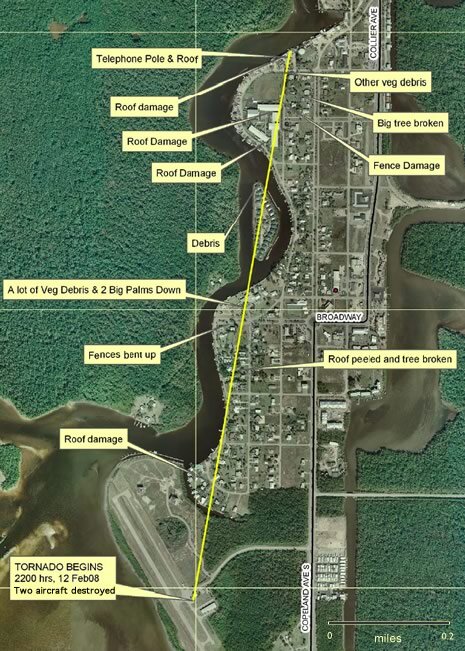CSI: NOAA Climate Scene Investigators

Marty Hoerling of NOAA’s Earth System Research Laboratory.
On the television show, CSI, Raymond Langston leads a team of forensic scientists who investigate brutal crimes to figure out who committed them. In NOAA's version of CSI, Marty Hoerling leads a group of climate and weather researchers who investigate killer climate patterns—heat waves, tornadoes, and floods-—to figure out what may have triggered them.
Working with colleagues across NOAA, Hoerling created Climate Scene Investigators (CSI) in 2007, partly as a response to the chaotic media coverage that resulted after NOAA announced 2006 as the hottest on record for the United States. The annual average U.S. temperature was 55°F that year, fully 2.2° above the 20th century average, according to a NOAA news release that went out in January 2007. Urgent questions began pouring in from the media, and NOAA scientists responded with the best information they had at hand. But there had been no organized effort to examine all the evidence related to extreme events, or to figure out what factors were responsible, Hoerling said.

In 2006, most counties in the contiguous United States reported annual average temperatures that were warmer than usual. Questions about the record-breaking heat inspired researchers to work together to understand the triggers for these conditions. Image courtesy of NOAA.
"Even within NOAA," he said, "we presented many different opinions on the cause of the record heat. Some said the record heat was because of global warming, while others insisted that it was not." Hoerling, a researcher in NOAA's Earth System Research Laboratory in Boulder, Colorado, noted that it quickly became clear that NOAA needed a team of experts who could investigate climate scene evidence and report findings to policy makers and the media in a timely manner.
The CSI team set themselves up to perform fast-response attribution work for future climate events. They armed themselves with computer models, historical data related to previous climate events, and recent observations that would help them understand the possible sources of unusual climate and weather patterns. Though it's not possible to attribute any single weather event to one specific cause in our complex climate system, they were willing to use the available tools to investigate the probabilities that various climate factors contributed to extreme events.
Hoerling said he thinks of the attribution team's work as "filling a gap" in NOAA. "Monitoring and prediction are two main branches of NOAA's climate services. Sitting between them is the service of explaining possible causes of climate conditions, or attribution," Hoerling explained. "Our fledgling NOAA-CSI effort at real-time climate attribution seeks to fill this gap. Our efforts help to explain the observed conditions, and those explanations help to inform predictions."
The Case of the February Tornadoes
In February 2008, when a public figure suggested that global warming might be the culprit behind a series of relatively unusual wintertime tornadoes in the Midwest and South, CSI quickly ran an attribution study. In an effort to link the tornadoes to one or more climate factors, researchers started by considering all the possible causes for the observed event. Factors from every part of the Earth system were suspect—the global increase in greenhouse gases, natural changes in ocean temperatures, and regional changes in land use, for example.

The yellow line on this map shows the path of a tornado through Everglades City, Florida on February 12, 2008. Graphic callouts describe some of the damage that occurred along the path. Image courtesy of Rick Zyvoloski, Collier County Emergency Management.
The CSI team ran climate models and examined historic records to check for sets of conditions that had produced similar events. "We found no evidence that warming enhances tornado activity," Hoerling said. "Rather, the CSI team uncovered research that showed an increase in tornadoes in North America was consistent with La Niña conditions."
La Niña, the counterpart to El Niño, is a natural climate pattern that occurs when cool ocean waters accumulate across a large swath of the tropical Pacific Ocean. Both El Niño and La Niña (together, referred to as El Niño-Southern Oscillation, or ENSO) can affect weather patterns around the globe. A La Niña episode had developed late in 2007 and peaked early the next year.
The CSI team had zeroed in on recent work that helped them break the case. In early 2008, NOAA and NWS researchers had just completed an analysis exploring the relationship of winter tornado outbreaks to ENSO, which can shift the location of the subtropical jet stream and other weather patterns. The work showed that wintertime tornado outbreaks were stronger and more frequent during La Niña and neutral conditions than during El Niños, and the storms occurred in different places, depending on ENSO phase. During El Niños, tornadoes tended to be limited to Gulf States, while neutral conditions allowed the storms to form farther north. But during La Niñas, outbreaks occurred in a band stretching all the way into the Midwest. In the case of the February tornadoes, La Niña appeared to deserve at least some of the blame.
The Case of the Midwest Floods
In the summer of 2008, NOAA's CSI team investigated the origin of devastating floods in the Midwest. The previous winter had brought heavy snowfall and rain to the Upper Midwest. Soils were saturated, and by the end of March, NOAA was already predicting high flood potential in three basins: The Mississippi, the Ohio, and the lower Missouri. Then came the rain. Between June 1 and 13, rivers and creeks in 10 Midwestern states swelled with rainfall that exceeded historic averages for those two weeks by six inches or more. Fresh from the work implicating La Niña in the tornadoes of February, CSI looked for evidence that the recent strong La Niña was also involved in the setup to the deadly floods.

On June 13, 2008, Iowa’s Cedar River crested at its highest level ever recorded, flooding 10 square miles of the city of Cedar Rapids, Iowa. Image courtesy of Don Becker, USGS.
La Niña had an alibi this time. Historically, La Niña conditions sent wet weather south and east of the regions rained out in 2008. In fact, a severe drought hit the Midwest during 1988, coincident with a strong La Niña. Though they looked at multiple lines of evidence, the team could find no evidence linking the flooding to La Niña.
Then, the team considered climate change. Published climate model runs indicated that extreme rain events fit within a much larger emerging pattern of changes in the water cycle that are related to global warming. Although climate models do not predict an increase in mean precipitation over the Midwest, observations and projections suggest that rainfall patterns are changing: the number of medium rain events is decreasing, while the numbers of light drizzles and heavy downpours are on the rise.
Publications by the United Nations' Intergovernmental Panel on Climate Change and the U.S. Global Change Research Program both note an increase in heavy precipitation events over North America during the last 50 years-conditions that are consistent with higher temperatures and more water vapor in the atmosphere. This, in turn, is consistent with the observed increase in greenhouse gases. Thus, evidence compiled by CSI suggests that human-caused global warming was a factor in the Midwest flooding disaster.
Public interest in the attribution of extreme weather events is growing. "Increasingly, decision-makers and the media want to know how well we understand the causes of regional and seasonal climate variation and trends," Hoerling said. "If an attribution study suggests, for example, that La Niña winters have a higher-than-normal likelihood of extreme snowfall events, communities can use that information to get ready for those conditions."
Veteran journalist Ann Schrader said Hoerling's assessment is spot-on. Schrader has written dozens of weather stories during her 30 years at the Denver Post newspaper. "Water resource managers, emergency planners, insurance companies...they all want attribution for extreme events," she said. "These groups are being asked to commit precious resources and they want to understand the risks posed by climate. They are also frequently asking the general public to comply with orders or requests for certain behaviors," Schrader said. "Attribution helps. It adds validity, and helps a great deal in explaining the science behind weather forecasting."
Further Reading:
NOAA's Climate Attribution Site. Accessed Oct 19, 2009.
References:
Climate Change Science Program Synthesis and Assessment Product 1.3, 2008: Reanalysis of Historical Climate Data for Key Atmospheric Features Implications for Attribution of Causes of Observed Change. A Report by the U.S. Climate Change Science Program and the Subcommittee on Global Change Research [Randall Dole, Martin Hoerling, and Siegfried Schubert (eds.)]. National Oceanic and Atmospheric Administration, National Climatic Data Center, Asheville, NC, 156 pp.
Climate Change Science Program Synthesis and Assessment Product 3.3, 2008: Weather and Climate Extremes in a Changing Climate. [Thomas Karl, Gerald Meehl, Christopher Miller, Susan Hassol, Anne Waple. William Murray (eds.)] Department of Commerce, NOAA's National Climate Data Center, Washington, D.C., USA, 164 pp.
IPCC, 2007: Summary for Policymakers. In: Climate Change 2007: The Physical Science Basis. Contribution of Working Group I to the Fourth Assessment Report of the Intergovernmental Panel on Climate Change [Solomon, S., D. Qin, M. Manning, Z. Chen, M. Marquis, K.B. Averyt, M.Tignor and H.L. Miller (eds.)]. Cambridge University Press, Cambridge, United Kingdom and New York, NY, USA.
The Relation of El Niño Southern Oscillation (ENSO) to Winter Tornado Outbreaks A. R. Cook and J. T. Schaefer, Monthly Weather Review, DOI: 10.1175/2007MWR2171.1